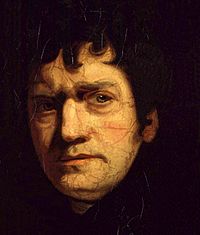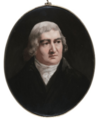John Wolcot facts for kids
Quick facts for kids
John Wolcot
|
|
|---|---|

Portrait of John Wolcot by John Opie, circa 1780 (detail)
|
|
| Born |
Dodbrooke, near Kingsbridge, Devon, England (baptised)
|
| Baptised | 9 May 1738 |
| Died | 14 January 1819 (aged 80) Somers Town, Middlesex, England
|
| Resting place | St Paul's, Covent Garden |
| Nationality | British |
| Other names | Peter Pindar |
| Alma mater | Aberdeen University |
| Occupation | Physician, Clergyman, Author |
John Wolcot (baptised 9 May 1738 – 14 January 1819) was a clever English writer. He was famous for his funny and sometimes sharp poems. He wrote under a special pen name, "Peter Pindar." A pen name is like a secret identity for a writer. He used his writing to make fun of people and ideas, which is called satire.
Contents
John Wolcot's Early Life
John Wolcot was baptised in a small town called Dodbrooke, near Kingsbridge, in Devon, England. We don't know exactly where he was born. His last name was spelled "Woolcot" in the church records.
An uncle helped him get his education. He later earned a medical degree from Aberdeen University in Scotland.
Life in Jamaica
In 1767, John Wolcot moved to Jamaica. He worked there as a doctor for Sir William Trelawny, who was the Governor of Jamaica.
While in Jamaica, he was offered a good job as a church leader in Saint Ann Parish. To take this job, he had to become a clergyman. So, he went back to England in 1769 to become a priest.
When he returned to Jamaica, the church leader in St. Ann's had gotten better. So, Wolcot was offered a different, less important church job in Vere. Sir William Trelawny died in 1772. After this, Wolcot decided to leave the church and go back to being a doctor.
He started his medical practice in a town called Truro in England. There, he met a talented young artist named John Opie. Wolcot saw Opie's skill and helped him with his art career.
Becoming Peter Pindar
In 1780, John Wolcot moved to London. This is where he started writing his funny and critical poems, known as satires. His first targets were the artists of the Royal Academy. People really liked these poems.
Soon, he started making fun of more important people. The King and Queen were often the main subjects of his jokes. Between 1785 and 1796, he published a long poem called The Lousiad. This poem was a funny story about a legend that a louse (a tiny insect) once appeared on the King's dinner plate!
In London, Wolcot became an important person in the art world. He helped not only John Opie but also another artist named Richard Morton Paye.
Wolcot's Targets and Humor
John Wolcot also wrote about other famous people. These included:
- James Boswell, who wrote a famous book about Samuel Johnson.
- James Bruce, an explorer who traveled to Abyssinia.
- Hannah More, a writer and playwright.
- Bishop Porteus, a church leader.
Wolcot had a great sense of humor and was very witty. His poems were very funny to people who weren't the targets. But they could really annoy the people he was making fun of! He was also very smart and good at creating memorable phrases.
Sometimes, his writing showed a gentle and kind side. This can be seen in some of his songs, like The Beggar Man and Lord Gregory. Many of his poems are not as well known today because the events he wrote about are forgotten. But enough of his work is still funny to show why he was so famous back then.
Music Inspired by Wolcot
The famous Austrian composer Joseph Haydn was inspired by one of Wolcot's poems. Haydn used Wolcot's poem To My Candle for his musical piece called Der Sturm. Haydn wrote this music when he visited London in 1791–1792.
Later Life and Death
John Wolcot passed away at his home in Latham Place, which is now part of Churchway in Somers Town, London. He died on January 14, 1819. He was buried in a special underground room at the churchyard of St Paul's, Covent Garden.
See also
- Pindar, an ancient Greek poet
Images for kids


